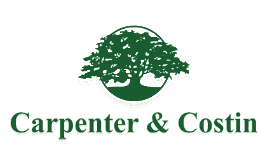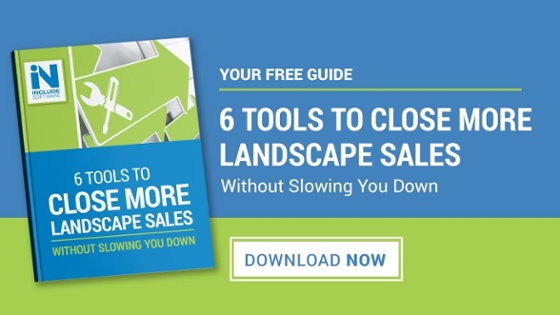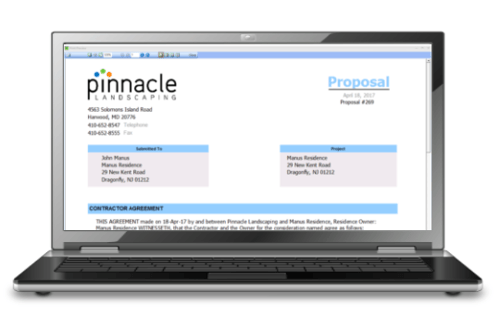Even after rapid growth, it’s not uncommon for landscape businesses to hit a plateau. After watching revenue steadily increase for several years, it can suddenly get “stuck” at a certain point. While this number can differ from business-to-business, it does seem that the $1 million mark is a particularly stubborn plateau where many business owners appear to level out. They did all the hard work to get to that mark and then suddenly they don’t know how to take it to the next level.
If you’ve leveled out and growth appears to be stagnant, you’re likely in need of a refreshed landscape sales strategy. Oftentimes what happens is that the strategies which worked at a lower level revenue may need revamping to accommodate the company’s needs at a higher level.
 Constantly keeping the game plan in mind, and refreshing it when necessary is something that has helped Russ Marsan, owner of Carpenter & Costin, a landscape design, construction, and maintenance firm based in Rutland, Vermont, to grow his business past stubborn plateaus. He says the company had previously plateaued at the $2 million mark. Now they are working on breaking the $3 million mark.
Constantly keeping the game plan in mind, and refreshing it when necessary is something that has helped Russ Marsan, owner of Carpenter & Costin, a landscape design, construction, and maintenance firm based in Rutland, Vermont, to grow his business past stubborn plateaus. He says the company had previously plateaued at the $2 million mark. Now they are working on breaking the $3 million mark.
We caught up with Marsan—whose business is an excellent example of a “sales machine” that continues to push itself to the next level—to find out some of his best landscape sales tips to grow a company. Marsan shared 7 of them with us that he really believes in.
1. Be Community-Minded
For us, being community-minded has helped drive sales quite a bit. How involved is your company in the local community? How well do you know the people you’re serving? Those factors make a big difference in your company’s overall success.
More often than not, growing businesses begin to shift their focus inward. While it’s not a bad thing to constantly be internally reviewing your business, you can’t lose sight of the people you’re serving. You must continue to also keep some focus on the community and ensuring that you’re meeting their needs.
Getting involved in charitable work in the community is one such way of doing that. We are personally very involved with the non-profit Come Alive Outside, an organization that is focused on bringing members of the community together to spend more time outside—in turn, reducing the obesity risk in children.
2. Be “Good” Busy
There is good busy and there is bad busy. Which are you? The answer to that question will say a lot about whether your business is growing or whether it’s stagnant. In a successful, growing business you must constantly evaluate how you’re spending your time. If you find that you’re getting caught up in a lot of “stuff”—that is small details that can be big time wasters—then you probably aren’t spending your time very wisely.
Business owners that are wearing a lot of hats often fall into this trap. As a small business they had to do it all themselves and as they’ve grown, they’ve struggled with delegating. You must delegate the “stuff” to others so you can use your time well. The exact answer as to how to spend your time will vary from business to business but the goal is the same—spend it wisely by being “good busy.” Spend it on things that are helping you sell more jobs and take your business to the next level.
3. Pre-Qualify Potential Leads
 Increasing revenue is all about finding ways to save time and we’ve found that pre-qualifying leads can be an excellent way to do just that. In other words, weed out the clients that aren’t going to be a good fit for your business. Early on in business, you often had to follow through on every potential lead that came in the door as the focus was on rapid growth. But once you reach a certain level you can start to be more selective.
Increasing revenue is all about finding ways to save time and we’ve found that pre-qualifying leads can be an excellent way to do just that. In other words, weed out the clients that aren’t going to be a good fit for your business. Early on in business, you often had to follow through on every potential lead that came in the door as the focus was on rapid growth. But once you reach a certain level you can start to be more selective.
Don’t run out the door every time the phone rings. If you do, you’re wasting valuable time. You have to be willing to say to people: “we’re probably not the right company for your needs.” It’s easy to figure that out on the phone without spending valuable face time meeting with clients that aren’t going to pan out. Develop some questions that you can ask people over the phone to “pre-qualify” them.
Also, communicate clear expectations for scheduling. Let prospects know exactly where they fit into your schedule and how long it would be until work can start.
If prospects don’t fit your criteria, don’t be afraid to turn down that work. It may seem counterintuitive to turn down business in order to grow but it all comes down to using your time where it’s most valuable.
4. Sell on Relationships—Not on Price
An important landscape sales strategy is to avoid the trap of always selling on price. In competitive markets, it is very easy to get caught up on price. But if you’ve set a price that you think is fair—even if you’re the most expensive—then hold firm to it. Don’t cave to the competition.
There are always going to be lowballers out there selling on price and it’s easy to stoop to their level when you feel as though you’re losing jobs. Getting a handle on your profitability and your inefficiencies will help get your price down to where it needs to be, not to undercut, but because you’re making smart decisions and tracking data.
Still, even with competitive pricing, you may not be the least expensive option, and that’s okay. The truth is, those fly-by-night companies will be here one day and gone the next. You want to land work based on relationships and on the value that you bring to the client—not because you underbid the competition. Be forthright in sharing why you cost more—but why you’re also worth it. What does your company bring to the table that your competition does not? Know the answer to that question and don’t be afraid to share it.
5. Shift Your Sales Focus to Problem Solving
 In general, salespeople can get a bad rap. They can be thought of as untrustworthy or not well-liked. These types of preconceived notions come from the quintessential, pushy salesperson that just wants to make their next dollar. Don’t approach sales that way.
In general, salespeople can get a bad rap. They can be thought of as untrustworthy or not well-liked. These types of preconceived notions come from the quintessential, pushy salesperson that just wants to make their next dollar. Don’t approach sales that way.
When your clients think of your company, do they think of pushy sales folks that are only interested in making the sale? Or do they think of these folks as problem solvers? You want it to be a latter. An excellent landscape sales strategy is to approach selling as a way of helping people fulfill their needs (or solve their problems) as opposed to just looking at it as a sale or a dollar figure.
The ability to create proposals that are valuable to a prospect is a great way for the sales team to be problem solvers—and to set your company apart from the competition. Integrating maps, diagrams, and other features (when applicable) into the proposal process is one such way to add value before you even attempt to close the deal. These added features will also help your operations team by assisting with work execution if the job sells.
6. Practice the 24-Hour Rule
 We always try to follow the 24-hour rule when dealing with landscape clients (and potential clients). As a salesperson or a business owner, if you meet with someone today, you should have contact with them by tomorrow.
We always try to follow the 24-hour rule when dealing with landscape clients (and potential clients). As a salesperson or a business owner, if you meet with someone today, you should have contact with them by tomorrow.
Keep the connection fresh and stay current in their mind. Thank them for their time, bring up a point they asked about and say you’re looking into it, or just touch base to give them a time frame of when you’ll have the proposal ready.
Nothing frustrates people more than a non-responsive company. In this day and age, we’re so used to instant (and constant) communication.
If a potential client is thinking about hiring you for work, an imperative landscape sales strategy is to keep in touch with them so that you don’t have any chance of falling off their radar.
Yes, try to get them the proposal as quickly as you can, but more than anything, just keep them in the loop.
7. Implement Landscaping Business Software to Boost Sales
 Among the landscape sales tips we’ve mentioned so far, this is one of the most helpful for us. Landscaping business software has multiple sales tools that have helped us to streamline our processes, save time, and ultimately sell more jobs. Among the tools that have helped us, the proposal generator has been invaluable. We have a lot of different templates based on what the project is, and all of them are set up with exactly what we need for the job. We are also able to create proposals that are valuable to the prospect with features like diagrams or maps, as previously mentioned.
Among the landscape sales tips we’ve mentioned so far, this is one of the most helpful for us. Landscaping business software has multiple sales tools that have helped us to streamline our processes, save time, and ultimately sell more jobs. Among the tools that have helped us, the proposal generator has been invaluable. We have a lot of different templates based on what the project is, and all of them are set up with exactly what we need for the job. We are also able to create proposals that are valuable to the prospect with features like diagrams or maps, as previously mentioned.
Different jobs have different processes but landscaping business software helps to streamline that information and have all of the data in one place. Implementing landscaping business software so that our team can estimate accurately and consistently—and in an efficient manner—has really helped refine the overall sales process. It’s not just about selling more, but about selling consistently, too.
A refined and efficient sales process has helped cut time—which is one of the most important things in a salesperson’s tool belt. Using time efficiently, and shortening the sales cycle, is a big deal when you only have so many work hours in a day.
Using a Landscape Sales Strategy to Grow Your Business
Marsan says that all 7 of his tips have a common thread and that is the importance of making a plan and executing it. Oftentimes businesses that become stagnant are ones that have lost sight of their plan, failed to follow through on it, or failed to make changes to it when necessary. Your plan must be fluid enough change when it’s not working.
“Our own landscape sales strategy has evolved many times over the years,” Marsan adds. “You’re never great, you just keep trying to be. If you reach a point in business where you think you’re great, then you’re putting yourself at risk of becoming stagnant because you stop trying to improve. I think you must always try your best to understand your company’s strengths and its weaknesses—and to continually work on improving both.”
For full disclosure’s sake, Marsan is one of our clients. He utilizes Asset to help manage his business and streamline his sales process. He says that one of his favorite aspects of the software is the fact that it’s an “all-in-one” tool. Rather than utilizing multiple platforms, Marsan appreciates the ability to use a single software platform to manage all aspects of his business—including, of course, sales. He says it’s absolutely been a tool to help grow his company, and we think it can be one to help grow yours, too.
If you’d like more information about Asset, contact us for a free demo or give us a call at 800-475-0311.



